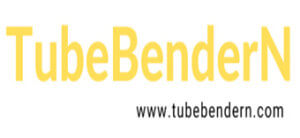A Deep Look into CNC Tube Bender
- What is A CNC Tube Bender?
- Features of CNC Tube Bender
- Technical Specifications of CNC Tube Bender
- Main Functions of CNC Tube Bender Control Software
- Main Electric Control Equipment of CNC Tube Bender
- Main Components of CNC Tube Bender
- How does A CNC Tube Bender Work?
- Benefits of Using CNC Tube Bender
- Applications of CNC Tube Bender
The CNC tube bender is an essential equipment for tube processing needs, capable of bending metal pipes into various shapes according to set parameters to meet the requirements of different industries. CNC tube bending is highly suitable for batch production of bent tubes, offering high precision and consistency.
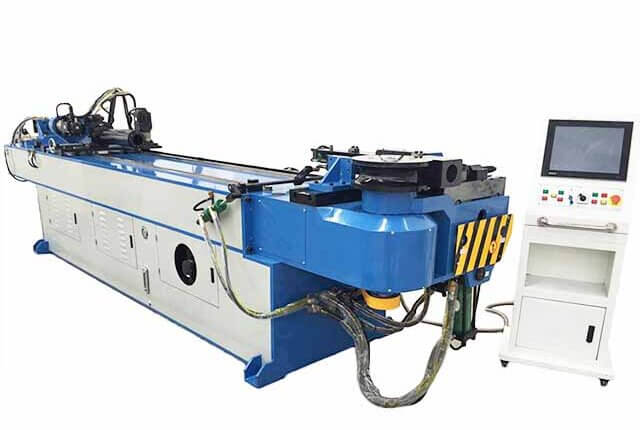
What is A CNC Tube Bender?
A CNC tube bender utilizes computer numerical control (CNC) technology to control the bending process and bend metal tubes and pipes at precise angles. The bending process is automatic and repeatable to ensure high accuracy and consistency.
Features of CNC Tube Bender
- CNC tubing bender applies to processing bendable materials such as steel pipe, stainless steel pipe, aluminum pipe, brass, and red copper.
- The CNC operating system is specially developed by our company on the WINDOWS platform for pipe bending machines.
- Servo system: Mitsubishi or Yaskawa.
- The control panel is movable, with the touch display screen and emergency stop switch.
- Operation modes: manual, step, and automatic.
- Automatic output counter.
- You only need to input the following parameters into the program:
Y- Feed amount of pipe
B- Bending angle
C- Rotating angle
You may also automatically convert them into Y, B, and C through 3D coordinate points X, Y, and Z (crossing points of the 3D coordinate of the pipe centerline). 3D images can be shown on display according to the input data of the pipe.
- When bending the pipe with a thin wall, the multi-ball mandrel and anti-wrinkle device may be used to solve the problems of ovality and internal wrinkling of the pipe.
- The system is operated through password administration privileges to prevent data from being tampered.
- Over 100,000 groups of pipe data can be stored; over 40 feed amounts, bending angles, and rotating angles of pipe can be set for a single pipe.
- Process positioning and real-time monitoring.
- Automatic fault warning function.
Technical Specifications of CNC Tube Bender
- The functions of the mechanic part, hydraulic system, and CNC system of the CNC pipe bender must meet the requirements of the product.
- CNC tube bending machine can ensure the bending radius R is equal to and greater than 1.5D (D-outer diameter of the pipe, R-bending mean diameter), the bent part is free of wrinkle (the distance between the center of bending mold and the central axis of clamping pipe).
- An adjustable hydraulic system is adopted to synchronize the main drive and side thrust movement during bending and has enough drive rigidity and speed synchronization performance.
- The linear rolling guide rail is adopted; the linear feed-in drive adopts gear and rack, and 3m long material can be fed for one time. The maximum bending angle of the rotating arm is 190°.
- The CNC system is adopted to control the bending angle, space angle, and feed amount, and form closed-loop control. The error of bending angle and space angle is not greater than 0.1°; linear feed-in error is not greater than 0.1mm.
- Angle compensation method: direct compensation by manually setting resilience value.
- There are two ways to input pipe bending parameters: input 3D coordinate points to automatically generate pipe bending parameters; and directly input pipe bending parameters.
- During the automatic operation of the machine, the breakpoint is set to facilitate manual intervention when bending a special pipe; the continuous automatic operation can also be restored. The machine is operated by a foot switch; a suspension function is provided for emergency stop. The operation can be manual and automatic; when starting the next cycle after one cycle, use the foot switch to start the automatic cycle; manual operation is easy and reliable.
- The hydraulic control valve adopts the hydraulic device of YUKEN company; the temperature of the oil tank and control of temperature rise meet the relevant national standards; the machine tool may be equipped with an air cooler (optional).
- The language of the operating interface can be set according to your requirements.
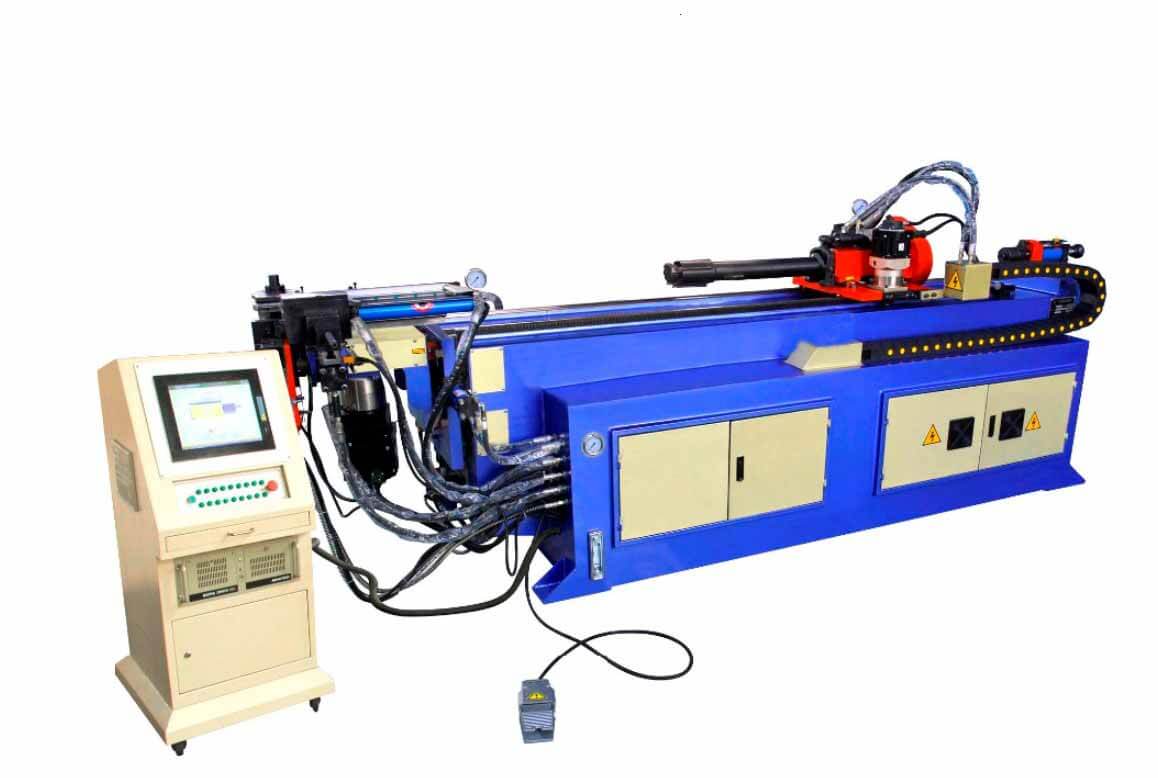
Main Functions of CNC Tube Bender Control Software
- System operating platform: Windows operating system.
- Input of bending parameters:
A: Operator directly inputs.
B: Input according to 3D coordinate points of drawing to automatically generate bending parameters (input according to 3D coordinate points (X, Y, and Z) of drawing, they can be converted into Y, B, and C values.
C: Parameters can be exported through U-disk and stored.
- The CNC pipe bending machine is equipped with an oil temperature cooling control system.
- Storage capacity of a single process: over 40 bending angle per part, unlimited part number; it has a memory function in case of a power failure and the data can be stored permanently.
- Interference protection selection function: interference protection of guide mold and supporting pipe, extreme position protection.
- Feed-in mode selection function: direct feed-in and clamping feed-in.
- Manual bending, semi-automatic, and full-automatic functions are available.
- The process of operating speed and action of each bearing can be set.
- Function of output counting to facilitate output statistics.
- Intelligent fault diagnosis functional sub-system can provide real-time alarms for processing faults under semi-automatic and automatic modes and hint at the fault cause and solution.
- The function of setting the loading position and stop position of the feeding mechanism.
- During the automatic operation of the machine, the breakpoint is set to facilitate manual intervention when bending an irregular-shaped tube; the continuous automatic operation can also be restored.
- During trial bending, the action can be manually separated to observe the interference point and modify the action.
- Automatic test function of each button and circuit input/output terminal shall be provided for easily finding the possible fault position.
Main Electric Control Equipment of CNC Tube Bender
Control system of IPC+PLC+servo system
- IPC is the control center of the system and the commander of the whole system responsible for input, explanation, display of the program, and sending action orders to PLC. The IPC of this system is a tablet IPC developed by the biggest IPC manufacturer in Taiwan.
- Servo controller.
- Mitsubishi or Yaskawa servo drive motor is adopted; the servo controller consists of a servo amplifier and servo motor, it is the actuator and is Responsible for the feeding mechanism and the rotation of the bending angle in space.
- Schneider’s low-voltage device is adopted to ensure the reliability of the whole system.
- Operating system: The Windows English operating system is used as an operating platform to make full use of the graphic function of Windows, good consistency, and easy use of interface, as well as man-machine dialog. The operating interface is a touch display with a menu and is convenient and visualized. Coordinate parameters (X, Y, and Z) can be automatically converted into pipe parameters (Y, B, and C). It has the functions of automatic and manual resilience compensation, 3D display of pipe shape, automatic diagnosis, and display of all system faults; the remote programming is possible and stored and managed through U-disk.
- Hierarchical authorization for operation: it means executing the operation by inputting the corresponding authorization password.
- Low authorization: for processing operations only.
- Medium authorization: for processing and programming operations.
- High authorization: for processing, programming, and setting use parameter operation.
Main Components of CNC Tube Bender
- Tablet computer
- PLC
- Servo motor
- Servo drive
- Reduction box
- Electromagnetic directional valve
- Relief valve
- Pressure regulating valve
- Pressure reducing valve
- Inductive switch
- Switch power
- Contactor
- Button
- Thermal overload relay
- Air switch
- Motor
- Oil cylinder
- Oil pipe
- Linear guide rail
- Seal
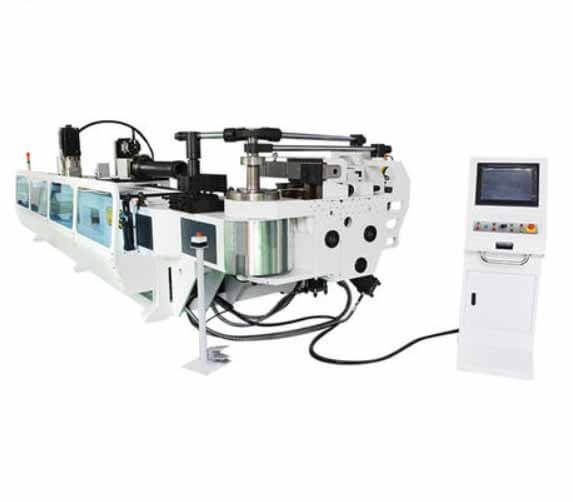
How Does a CNC Tube Bender Work?
CNC tube bender means the computer numerical control tube bending machine. The CNC tube bending machine uses the computer to control the mechanical parts and hydraulic system to shape the tube and pipe.
Benefits of Using CNC Tube Bender
In the event that your budget allows for it, we always recommend you use a CNC bending machine to bend metal tubes and pipes. Since CNC pipe bending will provide you with a lot of benefits.
High Precision
CNC mandrel tube bender provides high precision in tube bending, ensuring accurate bending size and angle.
High Efficiency
Automation provided by CNC technology allows for faster production cycles and reduced setup times.
High Consistency
Pipes and tubes bent by a CNC-controlled machine can ensure the consistency and repeatability of production.
Design Flexibility
CNC bender can create complex shapes in tube bending, while the NC type can not achieve complex bending results.
Cost Saving
Despite the initial investment, CNC tube bending can be cost-effective in the long run due to increased productivity and reduced labor costs.
Applications of CNC Tube Bender
There is a wide range of applications that need to use tube bending machines, some of them prefer the CNC tube bender to increase their product quality.
- Aerospace Industry (aircraft frames, hydraulic lines, and structural components)
- Automotive Industry (exhaust systems, roll cages, chassis components, and fluid transfer systems)
- Furniture Manufacturing (furniture frames, chair legs, and table bases)
- Construction and Architecture (handrails, balustrades, architectural features, and structural supports in buildings and infrastructure projects)
- HVAC (Heating, Ventilation, and Air Conditioning)
- Bicycle and Motorcycle Manufacturing (handlebars, and other components in the bicycle and motorcycle industries)
- Medical Equipment (surgical instruments, hospital beds, and diagnostic equipment)
- Marine Industry (ship components, boat frames, railings, and marine piping systems)
- Electronics and Electrical Enclosures (enclosures, racks, and mounting brackets for electronic equipment and control panels)
- Energy Sector (piping systems, heat exchangers, and structural components for power plants, renewable energy installations, and oil and gas facilities)
You may also interested in:
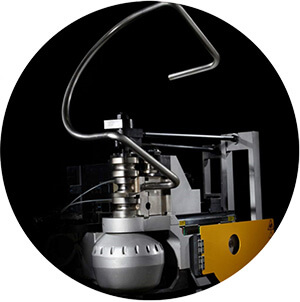
Denis Lau
Denis Lau has 20 years of work experience in the metal processing industry. His major in university was mechanical engineering, and after graduation, he started from the bottom of the workshop, gaining extensive hands-on professional experience and the ability to tackle challenges from various industries.
